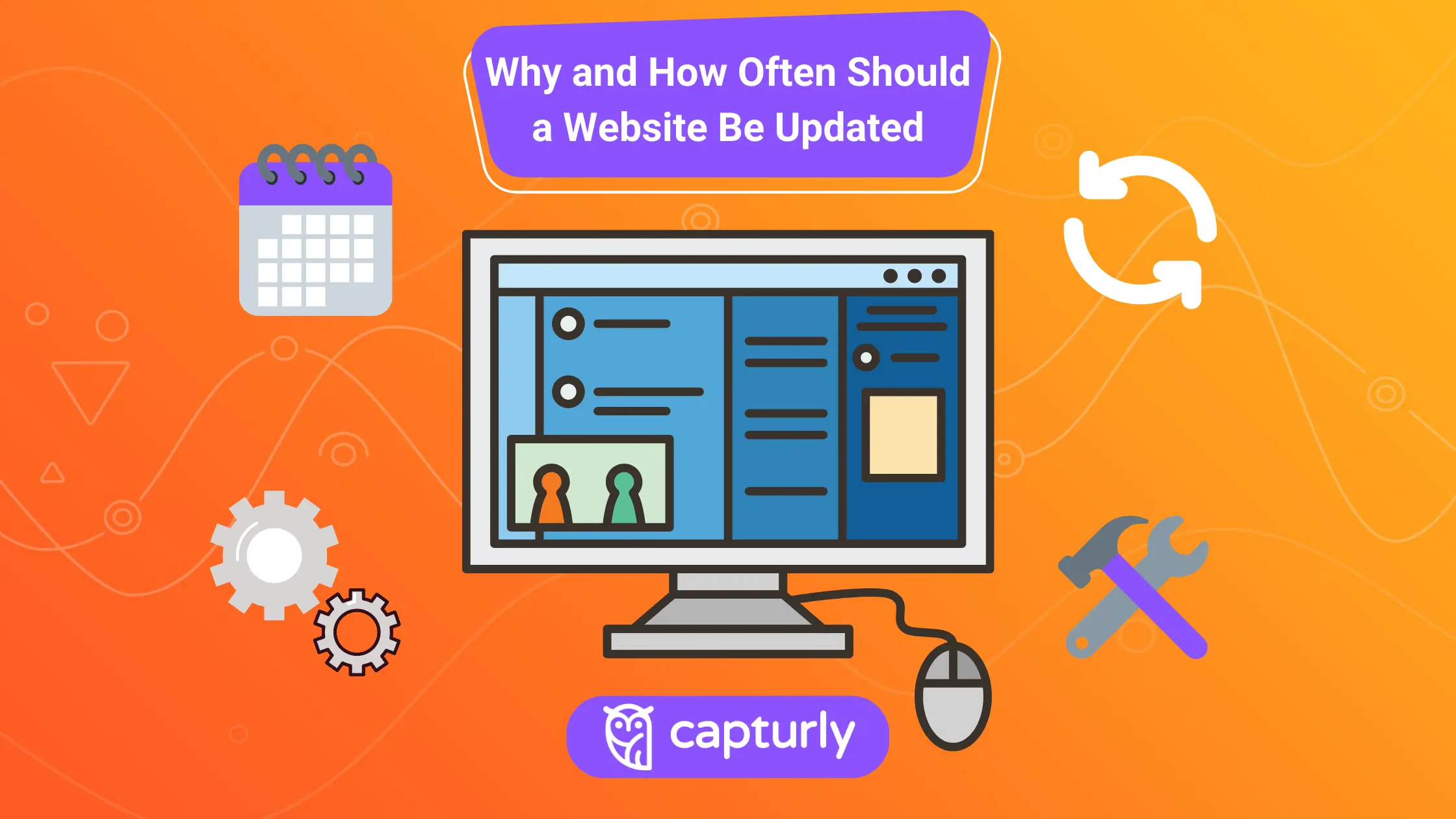A website is a living, breathing entity that needs to be updated regularly in order to keep it relevant and engaging for users. If you’re not updating your website consistently, you’re doing yourself and your business a huge disservice.
So, how often should a website be updated? The answer isn’t as cut and dry as you might think. It depends on a variety of factors, including the type of website, the purpose of the website, the amount of content on the website, and more.
If you’re not sure how to go about updating your website, or how often you should be doing it, don’t worry – we’re here to help. In this blog post, we’ll discuss why website updates are important and offer some guidelines on how often you should be updating your website.
Table of Contents
So, why are website updates so important? There are a few key reasons:
It Keeps Your Website Fresh
If you want people to keep coming back to your website, you need to give them a reason to do so. Regularly adding fresh, new content is one of the best ways – whether it’s adding new blog posts, updating your product offerings, or simply changing up the design of your website, new content will help keep people engaged. If you’re not adding new content to your page or blog section, then you stop trying to stay relevant, which will quickly lead to people losing interest in your site.
It Helps You Rank Higher in Search Engines
One of the main reasons you want people to visit your website is so that they can learn more about your business and what you have to offer. But if your website isn’t ranking high in search results, then it’s going to be very difficult for people to find you. Search engines like Google are constantly changing their algorithms, and one of the things they’re looking for is whether or not a website is being updated regularly. If your website hasn’t been updated in months or years, it’s going to be much harder to rank high in search engine rankings.
It Keeps Your Website Secure
If you’re not regularly updating your website, you’re leaving yourself open to security risks. Hackers are always finding new ways to exploit vulnerabilities in websites, and if your site isn’t up-to-date with the latest security patches, you could be at risk. By regularly updating your website, you can help ensure that your site is secure against the latest threats.
Factors to Consider When Updating a Website
Now that we’ve discussed some of the reasons why updates are important, let’s talk about how often you should be updating your website. As we mentioned earlier, there isn’t a one-size-fits-all answer to this question – it depends on a variety of factors. Here are a few things you should consider when determining how often to update your website:
The Type of Website
The type of website you have will play a big role in how often you need to update it. For example, if you have an eCommerce site, then you’ll need to regularly add new products and keep your inventory up-to-date. On the other hand, if you have a simple informational website, then you might not need to make as many updates.
The Purpose of the Website
The purpose of your website will also affect how often you need to update it. If you’re using your website primarily for blog posts or articles, then you’ll need to add new content on a regular basis. However, if your website is more static in nature, then you might not need to update it as often. Typically, static company websites only need to be updated when there are major changes, such as a change in address or a new product launch.

Nonetheless, if one of their business goals is constantly staying relevant, getting higher rankings in search engines, increasing site traffic, and generating leads and customers, then it would be beneficial for them to update their website more frequently. It could be regular updates about the company or their industry.
Your Industry
The industry you’re in will also play a role in how often you need to update your website. If you’re in a fast-paced industry where things are constantly changing, then you’ll need to update your website more often to keep up. On the other hand, if you’re in a slower-moving industry, then you might not need to update your site as frequently. Some fast-paced industries are technology, fashion, and current events while some slower-moving industries are history or automotive.
Your Competition
Finally, you should also consider your competition when determining how often to update your website. If all of your competitors are regularly updating their websites with new content and fresh designs, then you’ll need to do the same just to keep up. On the other hand, if none of your competitors are updating their websites very often, then you might not need to either.

As a general rule of thumb, most businesses should aim to update their website at least once per quarter. However, if you’re in a fast-paced industry or if you have a website that requires frequent updates, then you might need to spend time updating your site more often.
Signs that Your Website Needs an Update
Even if you don’t think your website needs an update, there are some signs that indicate it might be time for a refresh. If you’re seeing any of the following signs, then it’s probably time to give your website an update:
Your Website Looks Outdated
If your website looks like it was designed a decade ago, then it’s probably time for an update. A dated design can make your business look out-of-touch and unprofessional. Keep in mind that first impressions matter – if your website looks outdated, potential customers and clients will likely move on to one of your competitors.

Your Website isn’t Optimized for Mobile
In today’s world, more people are using their smartphones and tablets to browse the web than ever before. If your website isn’t optimized for mobile, then you’re missing out on a lot of potential traffic and customers. Not to mention, Google now uses mobile-friendliness as a ranking factor, so if your site isn’t optimized for mobile, it’s likely that you’re not getting as much organic traffic as you could be.
You’re Not Getting Much Traffic
If you’ve noticed that your website’s traffic has been declining recently, then it might be time for an update. Adding fresh content or redesigning your site can help to increase traffic and keep people coming back.
You’re Not Generating Many Leads
If your website’s primary purpose is to generate leads, then you should regularly check your lead generation metrics. If you’re not seeing as many leads as you’d like, then it might be time to update your site. Some of the reasons that you’re not generating leads could be that your website is outdated, your forms are too long or complicated, you don’t have clear call-to-actions, or you’re just not offering enough value.

Adding or changing call-to-actions, forms, and landing pages can help to increase the number of leads you’re generating.
You Have Broken Elements On Your Website
Having elements on your page that are not working is always a big no-no. Broken buttons, not working elements, error messages, and even not correctly loading pages happen easier than you would think. A small typo can cause big problems, so make sure you are on the lookout for them. A handy tool, like this JavaScript tracking feature, to help you notice these errors could go a long way.
Your Website isn’t Secure
If your website doesn’t have an SSL certificate, then it’s not secure. This means that any information submitted on your site (such as contact forms or payment information) is vulnerable to being intercepted by hackers. In addition to being insecure, websites without SSL certificates also get penalized by Google. So if your website isn’t secure, it’s time for an update.

You Just Did a Brand Refresh
If you’ve recently updated your brand, then it’s also time to update your website. Your website should always reflect your current branding, including your logo, colors, and overall style.
How Often Should You Update Your Website?
Now that we’ve discussed some of the reasons why it’s important to update your website, you might be wondering how often you should actually be doing it. The answer to this question will vary depending on a number of factors, including the type of website, the purpose of the website, and more.
Static Corporate Website
If you have a simple website with just a few pages of static content, then you probably don’t need to update it more than once or twice a year. Of course, if you have news or events that you want to share with your visitors, then you can update your website more frequently. But in general, a static corporate website doesn’t need to be updated too often.
Blogs and News Websites
If you have a blog or news website, then you’ll need to update your site much more frequently – ideally, on a daily basis. This is because people who visit these types of websites are looking for new, fresh content. If you’re not updating your site regularly, then they’ll quickly lose interest and move on to another site.
E-commerce Site or Online Store
On the other hand, if you have an e-commerce site with hundreds or even thousands of products, then you’ll need to update your site much more frequently. This is because you’ll need to add new products, update product descriptions and pricing, and more. Consistently adding relevant content on your blog page also plays a role in how often you should be updating your site in order to keep it on top of search engine rankings.

As a general rule of thumb, we recommend that most businesses should be updating their website at least once a month. This gives you enough time to make small changes and updates as needed, without overwhelming yourself or your team. Of course, if you have the resources to update your site more frequently, then you should definitely do so.
How to Update Your Website
Many businesses make the mistake of thinking that updating their website is a complicated and time-consuming process. But the truth is, it doesn’t have to be. There are a number of simple things you can do to keep your site up-to-date, without spending hours or even days making major changes.
Add New Content Regularly
One of the easiest ways to keep your website updated is to simply add new content on a regular basis. This could be in the form of blog posts, new product pages, news articles, or anything else that would be relevant to your visitors. If you’re not sure what kind of content to add, take a look at your competitors’ websites and see what they’re doing. You can also use Google Analytics to see which pages on your site are getting the most traffic, and then add similar content to those pages.

When you write content, make sure that it isn’t a duplicate of what is already on your website or on another page. Duplicate content will not only irritate your readers, but it can also have a negative impact on your SEO. In addition, ensure that you are publishing high-quality content that is well-written and contains valuable information that your potential clients will find useful or bring more traffic to your current website.
Update Existing Content Regularly
In addition to adding new content, you should also make sure to update your existing content on a regular basis. This could include updating product descriptions, blog posts, ongoing updates, and more. Updating content is a great way to show your visitors that you’re keeping up with the latest trends in your industry, and it can also help to improve your search engine rankings.
One thing to keep in mind when updating content is to not make too many changes at once. If you update too much content all at once, it can be confusing for your visitors and it can also be difficult to track which changes are having the most impact. Instead, focus on making a few small changes at a time and then monitoring the results based on your site’s performance.
Website Redesign Updates as Needed
Another way to keep your website updated is to make design updates as needed. This could involve anything from changing the color scheme of your site to adding new images, videos, or more pages. Regular website updates can also help to improve your search engine rankings since it shows that your site is active and relevant.

Of course, you don’t want to make too many changes all at once or you’ll risk overwhelming your visitors. When redesigning your website, start with small changes and then gradually add more as needed. You can also use A/B testing to see which design changes are having the most impact on your website’s performance.
Apart from layout changes, make sure that it is also mobile-friendly since more and more people are now using their smartphones to browse the internet. Mobile-friendliness is also a ranking factor for Google, so it’s something you definitely want to focus on if you’re looking to improve your SEO.
Utilize Social Media Promotions
Your social media pages also offer a great opportunity to promote your website and keep it updated. You can use social media to share new blog posts, announce product updates, run contests, and even incorporate short-form videos. Just make sure that you’re not spamming your followers with too many promotions, or you’ll risk losing them.

A good rule of thumb is to post one promotion for every ten pieces of content that you share. This way, you’re still providing valuable information to your followers while also promoting your website.
Invest in Your Marketing Efforts
Besides having an active social media presence, investing in off-page SEO and other digital marketing efforts can also help to keep your website updated. You can use link building to improve your search engine rankings, and you can also use other marketing channels like email marketing or pay-per-click advertising to drive traffic to your site. This way, you can ensure that your website is always getting the traffic and attention it needs.
Create a Content Calendar to Schedule Your Posts
One of the best ways to ensure that your website is being updated regularly is to create a content calendar. This will help you to schedule your posts in advance and make sure that you’re always publishing new content. You can use a tool like Google Calendar or Trello to create your content calendar, or you can simply use a spreadsheet.

Whichever method you choose, make sure that you update your calendar on a regular basis so that you can always be prepared with new content.
Keep Track of Your Stats
Finally, it’s important to keep track of your website’s stats so that you can see how your updates are impacting your traffic and performance. Google Analytics is a great free tool that you can use to track your website’s traffic, and you can also use other tools like Crazy Egg or HotJar to track user behavior.
![]()
By monitoring your stats, you can see which changes are having the most positive impact on your website. This will help you to determine which updates are worth investing more time and effort in, and it will also help you to avoid making changes that don’t improve your site’s performance.
Conclusion
As you can see, there are a number of different ways to keep your website updated. By adding new content, updating existing content, and making design changes as needed, you can ensure that your site is always fresh and relevant. In addition, investing in off-page SEO and other digital marketing efforts can help to drive traffic to your site and improve your search engine rankings. So if you’re looking to improve your website, be sure to keep these tips in mind and put them into practice!
Don't forget, sharing is caring! :)


2 Comments
API Flight Booking
2023-02-16 at 05:58Great read!
Lauren Rodriguez
2023-06-13 at 14:37I have read your blog on providing regular updates or news on your website.It was very interesting and helpful but I can add some extra points in your article. Here some extra points:
1.Review your current content and design.
2.Check your website’s data.
3.Evaluate your competitors’ websites.
4.Gather inspiration.
5.Add powerful multimedia elements.
These are some extra points to add to your article. Readers if you are confused about your web and App development , you can get a free consultation at Alakmalak technologies.Visit our site for more information.